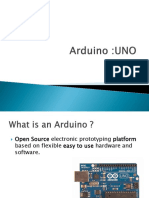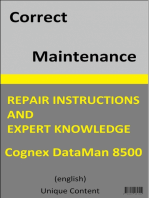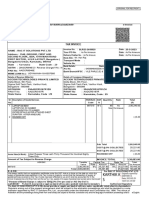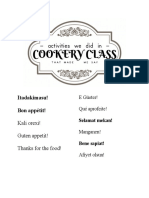0 ratings0% found this document useful (0 votes)
16 viewsAdvanced Arduino Techniques
Bbb
Uploaded by
dr.mahmoudaastCopyright
© © All Rights Reserved
We take content rights seriously. If you suspect this is your content, claim it here.
Available Formats
Download as PDF, TXT or read online on Scribd
0 ratings0% found this document useful (0 votes)
16 viewsAdvanced Arduino Techniques
Bbb
Uploaded by
dr.mahmoudaastCopyright
© © All Rights Reserved
We take content rights seriously. If you suspect this is your content, claim it here.
Available Formats
Download as PDF, TXT or read online on Scribd
You are on page 1/ 13
Advanced Arduino Techniques:
Integrating Sensors and Modules
from Theory to Practice
By: Mahmoud Hossam
analog vs digital pins
Understanding
Arduino Pins
• Analog Pins: Capable of reading
various voltage levels, used for
nuanced input like sensor data.
• Digital Pins: Read and write binary
(HIGH/LOW) signals, suitable for
switches, LED control.
• Voltage and Current Specifications:
Importance of adhering to specified
limits to avoid hardware damage.
Integrating MQ-3
Alcohol Sensor
• Sensor Overview: Detects alcohol
vapors, used in DIY breathalyzers.
• Connection Details: Connect to
Arduino’s analog pin for reading vapor
concentration.
• Calibration: Essential for accurate
readings; influenced by environmental
factors.
Utilizing MQ-2 Gas
Sensor
• Sensor Capabilities: Detects smoke
and various combustible gases.
• Connection Guide: Hooks up to an
analog pin to measure gas levels.
• Calibration and Safety: Regular
calibration needed for accurate
detection; critical for safety
applications like gas leak alarms.
Implementing
Ultrasonic Sensors
• Working Principle: Measures distance
by sending and receiving ultrasonic
waves.
• Connection Setup: Uses two digital
pins (trigger and echo).
• Distance Calculation: Time interval
between sending and receiving pulse
converted to distance.
Setting Up Bluetooth
Modules
• Functionality: Enables wireless
communication between Arduino and
devices.
• Serial Communication: Connects via
RX and TX pins.
• Baud Rate: Matching the baud rate in
Arduino and Bluetooth module is
crucial for connectivity.
Deploying Fire Sensors
• Function Overview: Detects flames
using infrared light.
• Digital Output: Connects to a digital
pin on Arduino.
• Programming Tips: Adjust sensitivity
and response time to enhance
reliability.
Controlling Buzzers
• Buzzer Operation: Generates sound
when activated by a digital signal.
• Connection: Controlled by a digital
pin (ON/OFF).
• Sound Patterns: Program different
patterns for various alerts and
notifications.
Managing Servos
• Servo Basics: Controlled via PWM
signal for precise position.
• Connection Details: PWM output from
Arduino controls movement.
• Programming: Set angle and speed;
used in robotics and automated
systems.
Driving DC Motors
• Overview: Essential for projects
requiring movement.
• Connection through Motor Drivers:
Necessary for speed and direction
control.
• Protection: Use diodes for back
voltage protection to safeguard
Arduino.
Incorporating Display
Screens
• Types of Displays: LCD and OLED for
project outputs.
• Connection: Digital pins used for data
transfer.
• Display Programming: Handling
memory and refresh rates for effective
information display.
Conclusion and
System Integration
• Combining Components: Integrating
multiple modules for complex
projects.
• Power Management: Crucial for stable
operation.
• Interface and Timing: Ensure smooth
operation of integrated systems.
You might also like
- Introduction To Arduino: (Programming, Wiring, and More!)No ratings yetIntroduction To Arduino: (Programming, Wiring, and More!)45 pages
- Artificial Intelligence in Business Decision MakingNo ratings yetArtificial Intelligence in Business Decision Making23 pages
- Security: Standard Operating Procedures: GuestsNo ratings yetSecurity: Standard Operating Procedures: Guests5 pages
- Title Sensors and Actuators With Arduino UNO Theory: InterfacingNo ratings yetTitle Sensors and Actuators With Arduino UNO Theory: Interfacing7 pages
- Arduino Programming For ESD: by MD - Dedarul Hasan100% (1)Arduino Programming For ESD: by MD - Dedarul Hasan38 pages
- Android App Development With Robotics Applications TrainingNo ratings yetAndroid App Development With Robotics Applications Training227 pages
- 66d172a85346099e4be9ec9e IOT102 INTRODUCTIONNo ratings yet66d172a85346099e4be9ec9e IOT102 INTRODUCTION24 pages
- Embedded Systems: Assist. Prof. Rassim Suliyev - SDU 2018 Week 4No ratings yetEmbedded Systems: Assist. Prof. Rassim Suliyev - SDU 2018 Week 430 pages
- Introduction To Arduino: // Basic Arduino Reference SheetNo ratings yetIntroduction To Arduino: // Basic Arduino Reference Sheet44 pages
- Ks0159 Keyestudio Desktop Bluetooth Mini Smart CarNo ratings yetKs0159 Keyestudio Desktop Bluetooth Mini Smart Car26 pages
- Arduino: Introduction & Programming: Course Instructor100% (1)Arduino: Introduction & Programming: Course Instructor29 pages
- Minor Project Report Controlling Computer With Hand Gestures Using Arduino and Python100% (5)Minor Project Report Controlling Computer With Hand Gestures Using Arduino and Python27 pages
- Arduino: GEET PATEL (13BEC072) Darp Raithatha (13bec084)No ratings yetArduino: GEET PATEL (13BEC072) Darp Raithatha (13bec084)17 pages
- Guided By-Dr. Shilpa Kabra: What Is Arduino?No ratings yetGuided By-Dr. Shilpa Kabra: What Is Arduino?22 pages
- BMP180 (Barometric Pressure Sensor) : Specifications100% (3)BMP180 (Barometric Pressure Sensor) : Specifications34 pages
- By M.Santhosh Kumar M.E Embedded Developer Spiro Solutions PVT LTDNo ratings yetBy M.Santhosh Kumar M.E Embedded Developer Spiro Solutions PVT LTD18 pages
- RWSA Presents James Hill Creek Texts by Mary Haas Episode 4No ratings yetRWSA Presents James Hill Creek Texts by Mary Haas Episode 433 pages
- Aerospace Material Specification: Cartridges, Grease, 14 Ounce (For Cartridge-Type Grease Gun) FSC 4930No ratings yetAerospace Material Specification: Cartridges, Grease, 14 Ounce (For Cartridge-Type Grease Gun) FSC 493010 pages
- Mr Wrong Number 1st Edition Lynn Painter - Download the full ebook version right nowNo ratings yetMr Wrong Number 1st Edition Lynn Painter - Download the full ebook version right now45 pages
- Passacaglia: Passacaglie Sp. Pasacalle, Passacalle)No ratings yetPassacaglia: Passacaglie Sp. Pasacalle, Passacalle)8 pages
- Indeterminate Sentence Law and Probation LawNo ratings yetIndeterminate Sentence Law and Probation Law6 pages
- 2025 Baseline Test GRADE 12 MATHEMATICS_No ratings yet2025 Baseline Test GRADE 12 MATHEMATICS_8 pages

























































































